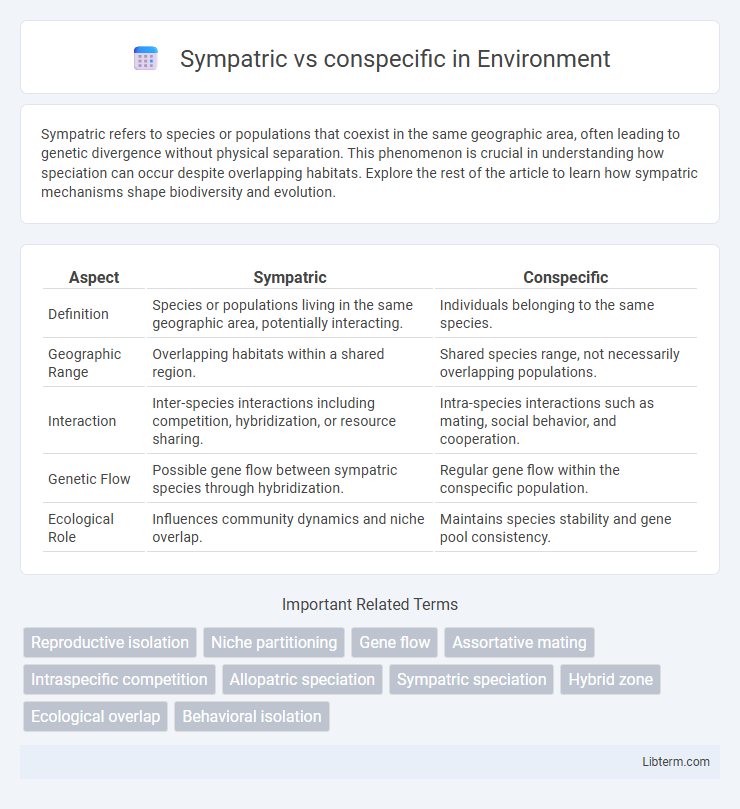Sympatric refers to species or populations that coexist in the same geographic area, often leading to genetic divergence without physical separation. This phenomenon is crucial in understanding how speciation can occur despite overlapping habitats. Explore the rest of the article to learn how sympatric mechanisms shape biodiversity and evolution.
Table of Comparison
| Aspect | Sympatric | Conspecific |
|---|---|---|
| Definition | Species or populations living in the same geographic area, potentially interacting. | Individuals belonging to the same species. |
| Geographic Range | Overlapping habitats within a shared region. | Shared species range, not necessarily overlapping populations. |
| Interaction | Inter-species interactions including competition, hybridization, or resource sharing. | Intra-species interactions such as mating, social behavior, and cooperation. |
| Genetic Flow | Possible gene flow between sympatric species through hybridization. | Regular gene flow within the conspecific population. |
| Ecological Role | Influences community dynamics and niche overlap. | Maintains species stability and gene pool consistency. |
Understanding Sympatric and Conspecific: Key Definitions
Sympatric refers to different species or populations inhabiting the same geographic area, allowing for potential interaction and competition, while conspecific pertains to individuals belonging to the same species. Understanding sympatric interactions is crucial for studying ecological dynamics and evolutionary processes such as speciation and niche differentiation. Recognizing conspecific relationships helps in identifying social behaviors, mating patterns, and population structure within a species.
The Origin of Sympatric and Conspecific Terminology
The terminology "sympatric" originates from the Greek roots syn- meaning "together" and patrikos referring to "fatherland," used to describe species or populations occurring in the same geographic area, facilitating potential interbreeding. In contrast, "conspecific" derives from Latin roots con- meaning "together" and species, identifying individuals belonging to the same species regardless of their spatial distribution. These terms are fundamental in evolutionary biology and ecology for classifying relationships and interactions based on spatial coexistence versus taxonomic identity.
Sympatric Species: Meaning and Examples
Sympatric species occur in the same geographic area, sharing habitats without physical barriers, which allows direct interaction and potential competition for resources. Examples include cichlid fish in African rift lakes, where diverse species coexist and adapt to various ecological niches. This contrasts with conspecifics, which are individuals belonging to the same species, regardless of their geographic distribution.
Conspecific Organisms: Clarifying the Concept
Conspecific organisms are individuals belonging to the same species, sharing genetic, ecological, and behavioral characteristics that facilitate mating and reproduction within their populations. Unlike sympatric species that coexist in the same geographic area but belong to different species, conspecifics maintain species integrity through gene flow and reproductive compatibility. Understanding conspecific relationships is crucial for studying population dynamics, evolutionary processes, and conservation strategies.
Comparing Sympatric vs Conspecific: Main Differences
Sympatric refers to populations or species coexisting in the same geographic area, allowing for potential interaction, while conspecific specifically denotes individuals belonging to the same species regardless of location. The main differences lie in scope: sympatric involves spatial overlap and ecological relationships among different species or populations, whereas conspecific focuses on taxonomic identity within a single species. Understanding these distinctions is crucial for studies in evolutionary biology, speciation, and population dynamics.
Ecological Significance of Sympatric Species
Sympatric species, which coexist in the same geographic area without physical barriers, play a crucial role in maintaining biodiversity by promoting niche differentiation and resource partitioning. This ecological arrangement fosters evolutionary processes such as character displacement and reproductive isolation, ultimately driving speciation despite gene flow between populations. Understanding sympatric species interactions enhances conservation strategies aimed at preserving complex ecosystems with overlapping species distributions.
Behavioral Interactions Among Conspecifics
Behavioral interactions among conspecifics in sympatric populations often involve complex communication and social structures that enhance cooperation or competition within the same species. These interactions can include territorial displays, mating rituals, and resource sharing, which play a crucial role in maintaining population dynamics and species cohesion. Understanding these behaviors helps clarify how conspecifics coexist and adapt in overlapping habitats, influencing evolutionary trajectories.
Role in Evolution: Sympatric vs Conspecific Dynamics
Sympatric populations evolve within the same geographic area, promoting speciation through ecological niche differentiation and reproductive isolation without physical barriers. Conspecific individuals belong to the same species, sharing gene flow that maintains genetic cohesion and limits divergence. The interplay between sympatric divergence and conspecific gene flow shapes evolutionary pathways by balancing adaptive radiation and genetic unity.
Case Studies: Sympatric and Conspecific Relationships in Nature
Case studies of sympatric and conspecific relationships highlight the complex interactions within shared habitats and species boundaries. Research on Darwin's finches in the Galapagos Islands demonstrates sympatric speciation through niche differentiation despite overlapping territories, while studies on conspecific populations of African cichlids reveal genetic flow and behavioral cohesion maintaining species integrity. These examples illustrate how ecological factors and reproductive strategies drive evolution and biodiversity in natural environments.
Implications for Conservation and Biodiversity
Sympatric species coexist in the same geographic area, increasing the complexity of conservation strategies due to their potential for niche overlap and hybridization, which can impact genetic diversity. Conspecific populations, belonging to the same species but often isolated, require targeted management to maintain genetic flow and prevent inbreeding depression, vital for preserving adaptive potential. Understanding the distinctions between sympatric and conspecific dynamics aids in designing effective biodiversity conservation plans that address species interactions and genetic health.
Sympatric Infographic

 libterm.com
libterm.com